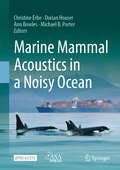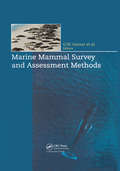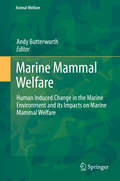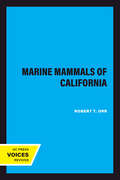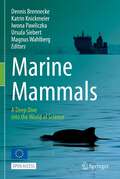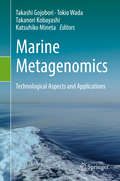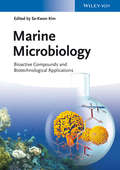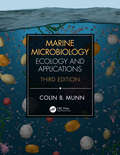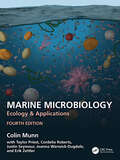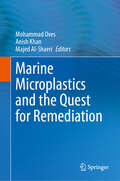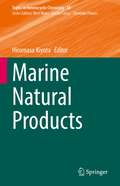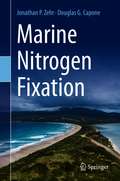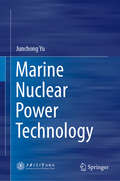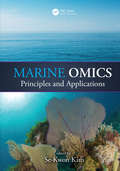- Table View
- List View
Marine Macro- and Microalgae: An Overview
by F. Xavier Malcata Isabel Sousa Pinto A. Catarina GuedesThe marine environment accounts for most of the biodiversity on our planet, while offering a huge potential for the benefit and wellbeing of mankind. Its extensive resources already constitute the basis of many economic activities – but many more are expected in coming years. This book covers current knowledge on uses of marine algae to obtain bulk and fine chemicals, coupled with optimization of the underlying production and purification processes. Major gaps and potential opportunities in this field are discussed in a critical manner. The currrent trends pertaining to marine macro- and microalgae are explained in a simple and understandable writing style. This book covers a wide variety of topics, and as such it will be appropriate as both student text and reference for advances researchers in the field.
Marine Macrophytes as Foundation Species
by Emil OlafssonMarine macrophytes (macroalgae, seagrasses, and mangroves) comprise thousands of species distributed in shallow water areas along the world’s coastlines. They play a key role in marine ecosystems regarding biodiversity and energy flow. A large proportion of macrophyte species can be characterised as ecosystem engineers—organisms that directly or indirectly affect the availability of resources to other species by modifying, maintaining, and creating habitats. <P><P>This book is divided into three main themes: <li>Marine macroalgae and seagrasses as sources of biodiversity gives an overview of the diversity of the main organisms associated with macrophytes, and their functional role and interactions within their hosts. <li> Primary and secondary production of Macrophytes synthesizes research on food web structures derived from/or associated with, macrophytes and the transfer of macrophytic primary and secondary production from one ecosystem to another. <li> Threats to macrophytic ecosystem engineers addresses human-induced effects including eutrophication, physical destruction, invasive species, and global warming. <P><P>The book is among the first one to concentrate on the value of macrophytes for the well-being of marine habitats. The book is aimed at academics but may be useful for students, policy makers, and laymen alike.
Marine Mammal Acoustics in a Noisy Ocean
by Michael B. Porter Christine Erbe Dorian Houser Ann BowlesThis open-access book invites its readers to dive into the depths of marine mammal bioacoustics. The ocean is a noisy place—naturally as well as anthropogenically. Our book explores the fundamentals of ocean acoustics, revealing the intricate sources of underwater noise that challenge marine life. Readers delve into the unique vocalizations of mysticetes, odontocetes, pinnipeds, otters, and sirenians, uncovering their diverse communication in stormy waters. The book presents research on marine mammal hearing and the impact of noise on their physiology and behavior, from the subtle behavioral responses to the broader biological significance of these effects. With insights into the management of anthropogenic noise, this book equips students, researchers, environmental managers, policy makers, conservationists, and enthusiasts alike with vital knowledge for protecting our ocean’s acoustic environments.
Marine Mammal Health and Disease
by Julia ZaiasA practical and authoritative reference for veterinary practitioners and technicians working with marine mammals in managed care or in free-ranging populations In Marine Mammal Health and Disease, distinguished veterinarian researcher Dr. Julia Zaias delivers an up-to-date and practical discussion of how to assess health and disease in marine mammals. The author offers a foundational, high-level understanding of normal/baseline conditions, how this baselines is altered by infectious agents, environment, or the host itself, and how to diagnose these changes and diseases. The book’s chapters are logically organized by health assessment and management, environmental influences on health, the basis of marine mammal health, disease, and animal welfare. It covers cetaceans, sirenia, pinnipeds, and other marine carnivores, as well as the pathology of cells and tissues, the mechanisms of disease, inflammation, and etiologic disease factors. Readers will also find: A thorough introduction to the basis of health and disease in marine animalsComprehensive explorations of health assessment and management, including clinical pathology and general preventative medicine and diagnosticsPractical discussions of both marine mammals in managed care environments and free-ranging animalsComplete treatments of environmental influences on health and disease in marine animals Perfect for students in veterinary and veterinary tech programs, conservation biology and medicine students, and marine mammal conservationists, managers, and trainers, Marine Mammal Health and Disease will also benefit researchers, wildlife and zoological veterinarians, veterinary technicians, and aquarium specialists and facility staff.
Marine Mammal Physiology: Requisites for Ocean Living (CRC Marine Biology Series)
by Michael A. Castellini Jo-Ann MellishSuppose you were designing a marine mammal. What would you need to think about to allow it to live in the ocean? How would you keep it warm? What would you design to allow it to dive for very long periods to extreme depths? Where would it find water to drink? How would you minimize the cost of swimming, and how would it find its prey in the deep an
Marine Mammal Survey and Assessment Methods
by Steven C. Amstrup J.L Laake D.G. Robertson B.F.J ManlyThis volume comprises the proceedings of a symposium on marine mammal survey assessment methods, which took place in Seattle, Washington, USA.
Marine Mammal Welfare
by Andy ButterworthMarine mammals attract human interest – sometimes this interest is benign or positive – whale watching, conservation programmes for whales, seals, otters, and efforts to clear beaches of marine debris are seen as proactive steps to support these animals. However, there are many forces operating to affect adversely the lives of whales, seals, manatees, otters and polar bears – and this book explores how the welfare of marine mammals has been affected and how they have adapted, moved, responded and sometimes suffered as a result of the changing marine and human world around them. Marine mammal welfare addresses the welfare effects of marine debris, of human traffic in the oceans, of noise, of hunting, of whale watching and tourism, and of some of the less obvious impacts on marine mammals – on their social structures, on their behaviours and migration, and also of the effects on captivity for animals kept in zoos and aquaria. There is much to think and talk about – how marine mammals respond in a world dramatically influenced by man, how are their social structures affected and how is their welfare impacted?
Marine Mammals and Low-Frequency Sound: Progress Since 1994
by Committee to Review Results of ATOC's Marine Mammal Research ProgramA report on Marine Mammals and Low-Frequency Sound
Marine Mammals of California (California Natural History Guides #29)
by Robert T. OrrThis title is part of UC Press's Voices Revived program, which commemorates University of California Press’s mission to seek out and cultivate the brightest minds and give them voice, reach, and impact. Drawing on a backlist dating to 1893, Voices Revived makes high-quality, peer-reviewed scholarship accessible once again using print-on-demand technology. This title was originally published in 1972.This title is part of UC Press's Voices Revived program, which commemorates University of California Press’s mission to seek out and cultivate the brightest minds and give them voice, reach, and impact. Drawing on a backlist dating to 1893, Voices Revived</DIV
Marine Mammals: A Deep Dive into the World of Science
by Dennis Brennecke Katrin Knickmeier Iwona Pawliczka Ursula Siebert Magnus WahlbergThis highly-readable Open Access textbook provides basic background information about marine mammals and anthropogenic impacts on them. The book includes inspiring exercises for education school programs in natural sciences. The book also provides advice on career paths using case studies of marine scientists and veterinarians describing their journeys from student to profession. By sharing real-life career paths, readers find answers to questions such as “What needs to be considered when choosing a career in science?” and “What kind of tasks do scientists undertake on a daily basis?” Marine mammals are amongst some of the most celebrated creatures on Earth, with their high intelligence, social and communicating skills, and capacity for deep diving. Alongside general information about marine mammals, the book aims at generating awareness of the impact of litter and noise pollution on the marine environment using marine mammals as an example. Huge numbers of marine animals, including marine mammals, die every year from entanglement in fishing gear, by ingestion of litter or because of chemical pollution. In the last decade many technological and scientific tools have been developed to aid research, for instance miniaturised sound recorders which can be attached to cetaceans and seals and record noise levels around them, their vocal production as well as their diving behaviour. This Open Access textbook can be used by undergraduate students interested in the fundamentals of marine mammal biology and medicine, and in pursuing the profession of a marine scientist.
Marine Mammals: Adaptations for an Aquatic Life
by Randall W. DavisThis comprehensive book provides new insights into the morphological, metabolic, thermoregulatory, locomotory, diving, sensory, feeding, and sleep adaptations of Cetacea (whales and dolphins), Pinnipedia (seals, sea lions and walrus), Sirenia (manatees and dugongs) and sea otters for an aquatic life. Each chapter reviews the discoveries from previous studies and integrates recent research using new techniques and technology. Readers will gain an understanding of the remarkable adaptations that enable marine mammals to spend all or most of their lives at sea, often while hunting prey at depth.
Marine Mammals: The Evolving Human Factor (Ethology and Behavioral Ecology of Marine Mammals)
by Bernd Würsig Giuseppe Notarbartolo di SciaraThe seventh volume in the series “Ethology and Behavioral Ecology of Marine Mammals” describes aspects of the often-complex relationship between humans and marine mammals. From a primeval condition of occasional predators, during the last century humans have become a major factor negatively affecting the status of most marine mammals through over-hunting, habitat encroachment and environmental degradation. This has led to the extirpation of many marine mammal populations and even to the extinction of species. However, in parallel to this destructive drive, since antiquity humanity has been influenced by a strong fascination for marine mammals, which contributes today to an increased human appreciation of the natural world admixed with widespread concern for its degrading condition. The special status occupied by marine mammals in human imagination and affection stands in stark contrast with the current predicament of many populations still threatened by the doings of Homo sapiens: a condition emblematic of the relationship of humanity with nature, and key to understanding where humanity is heading.
Marine Metagenomics: Technological Aspects and Applications
by Takashi Gojobori Tokio Wada Takanori Kobayashi Katsuhiko MinetaThis book presents the state-of-art marine metagenome research and explains the method of marine metagenomic analysis in an easy-to-understand manner.Changes in the marine environment due to global warming and pollution have become a major global problem. Maintaining a healthy marine ecosystem requires advanced environmental monitoring and assessment systems. As such, the book presents a novel metagenomic monitoring method, which has been developed for comprehensive analyses of the DNA of microorganisms living in seawater to further our understanding of the dynamics of the marine environment. The book can be used as a primer for new researchers and as a manual on experimental methods.
Marine Microbial Bioremediation
by Anjana K Vala Dushyant R Dudhagara Bharti P DaveIncreased industrialization and urbanization has polluted the marine environment, the largest ecosystem. Hence, sincere efforts must be made to decontaminate marine ecosystem for sustainable use of oceans and their bioresources. Microbial population in the marine environment plays a very crucial role in degrading, transforming and detoxifying the pollutants. This book presents contributions from leading scientists across the globe who have worked extensively on polluted marine ecosystem in removal of pollutants, mycoremediation of salinity ingressed soils, etc. This book will be useful to the scientific community, stake holders and policy makers involved in research related to environmental microbiology and marine microbiology in particular. The book will also be of benefit to the student community interested in marine microbial bioremediation.
Marine Microbiology
by Se-Kwon KimDeliberately breaking with the classical biology-centered description of marine organisms and their products, this reference emphasizes microbial technology over basic biology, setting it apart from its predecessors. As such, it systematically covers the technology behind high-value compounds for use as pharmaceuticals, nutraceuticals or cosmetics, from prospecting to production issues.Following a definition of the field, the book goes on to address all industrially important aspects of marine microbial biotechnology. The first main part contains a description of the major production organisms, from archaebacteria to cyanobacteria to algae and symbionts, including their genetic engineering. The remaining four parts look at commercially important compounds produced by these microorganisms together with their applications. Throughout, the emphasis is on technological considerations, and the future potential of these organisms or compound classes is discussed. A valuable and forward-looking resource for innovative biotechnologists in industry as well as in academia.
Marine Microbiology: Ecology & Applications
by Colin B. MunnThe third edition of this bestselling text has been rigorously updated to reflect major new discoveries and concepts since 2011, especially progress due to extensive application of high-throughput sequencing, single cell genomics and analysis of large datasets. Significant advances in understanding the diversity and evolution of bacteria, archaea, fungi, protists, and viruses are discussed and their importance in marine processes is explored in detail. Now in full colour throughout, all chapters have been significantly expanded, with many new diagrams, illustrations and boxes to aid students’ interest and understanding. Novel pedagogy is designed to encourage students to explore current high-profile research topics. Examples include the impacts of rising CO2 levels on microbial community structure and ocean processes, interactions of microbes with plastic pollution, symbiotic interactions, and emerging diseases of marine life. This is the only textbook addressing such a broad range of topics in the specific area of marine microbiology, now a core topic within broader Marine Science degrees. A Companion Website provides additional online resources for instructors and students, including a summary of key concepts and terminology for each chapter, links to further resources, and flashcards to aid self-assessment.
Marine Microbiology: Ecology & Applications
by Colin Munn Taylor Priest Cordelia Roberts Justin Seymour Joanna Warwick-Dugdale Erik ZettlerThe fourth edition of this bestselling text has been rigorously updated to reflect major new discoveries and concepts since 2019. This new edition reflects important new findings in marine microbiology revealed by development of high-throughput sequencing, meta-omics, and single-cell technologies, and the ability to analyse and interpret large datasets. Furthermore, it presents major new insights into topics such as the physiology of planktonic microbes and their role in ocean processes; the impacts of rising CO2 levels and climate change on the microbial community structure and ocean processes; the evolution of viruses, organelles, and eukaryotic life; interactions of microbes with plastic pollution; and emerging diseases of marine life and their control. All chapters have been significantly expanded, with full colour diagrams, illustrations, and boxes to aid students’ interest and understanding. Novel pedagogy is designed to encourage students to explore current high-profile research topics.This is the only textbook addressing such a broad range of topics in the specific area of marine microbiology, now a core topic within broader marine science degrees.
Marine Microplastics and the Quest for Remediation
by Mohammad Oves Anish Khan Majed Al-ShaeriThis informative book discusses the issue of microplastic pollution in marine environments. It explains the intricate ways in which these minuscule particles have crept into the world's oceans, impacting marine life, ecosystems, and, ultimately, human health. The book provides a detailed depiction of pristine marine environments, which are increasingly being compromised by microplastic pollution. The effects of these microplastics are the main focus of the book. It provides alarming evidence that marine life – from the tiniest plankton to the largest whales – mistakenly identifies microplastics as food. Plastics are introduced into the food chain, accumulating in the trophic levels of humans, in addition to causing internal obstructions and health problems for the animals. The book also shows how microplastics can carry infections and toxins, amplifying their negative consequences. It discusses cutting-edge technical solutions for ocean cleanup, as well as international agreements and laws aimed at trash management and plastic production. The book emphasizes the value of scientific investigation in determining the full scope of the issue and in creating biodegradable substitutes for conventional plastics. This book will be of significant interest to environmental enthusiasts and activists; academics, scientists, and researchers studying marine biology, oceanography, and environmental science; policymakers and government agencies; as well as industry professionals working in plastics manufacturing, waste management, and environmental consulting.
Marine Natural Products (Topics in Heterocyclic Chemistry #58)
by Hiromasa KiyotaThis book is a compilation of the latest achievements of leading researchers in marine natural products with extremely diverse structures and biological activities. It presents discussions of isolation, structure elucidation, biosynthesis, total synthesis, and biochemical properties of the compounds with characteristic structures such as macrolides, cyclic depsipeptides, alkaloids, and water-soluble heterocyclic low-molecular-weight compounds, from sponges, bacteria, cyanobacteria, flagellates, and other such organisms. The book especially focuses on heterocyclic natural products as a title in the book series, Topics in Heterocyclic Chemistry.
Marine Natural Products Research in South-East Asia: Current Status and Perspectives
by Lik Tong Tan Novriyandi HanifThis unprecedented volume offers a comprehensive review of marine natural products research across Southeast Asia, a region teeming with untapped marine biodiversity. It provides an extensive survey of the chemistry and biology of specialized metabolites derived from marine organisms, such as sponges, tunicates, soft corals and marine microbes. Highlighting both the scientific advances and critical gaps, the book identifies strategic areas for future research and drug discovery initiatives. With its regional focus and collaborative insights, this edited collection serves as a vital resource for researchers, policymakers, and industry stakeholders engaged in marine biotechnology and sustainable pharmaceutical development in one of the world&’s most biodiverse marine ecosystems.
Marine Niche: Translational Research
by Chaitanya G. Joshi Neelam M Nathani Chandrashekar Mootapally Indra R. Gadhvi Bharat MaitreyaThis book offers a comprehensive study of biological molecules acquired from marine organisms, which have been exploited for drug discovery with the aim to treat human diseases. Biomolecules have potential impacts on a diverse range of fields, including medical and pharmaceutical science, industrial science, biotechnology, basic research, molecular science, environmental science and climate change, etc. To understand and effectively apply medicinally important biomolecules, multidisciplinary approaches are called for. The ocean remains a rich biological resource, and the vast untapped potential of novel molecules from marine bio-resources has caught the interest of more and more researchers. These novel biological compounds have never been found in terrestrial or other ecosystems, but only in this rich niche. Advances in sampling techniques and technologies, along with increased funding for research and nature conservation, have now encouraged scientists to look deeper in the waters. Aquaculture supports both tremendous seafood production and the bulk production of marine-derived drugs. Furthermore, molecular methods are now being extensively employed to explore the untapped marine microbial diversity. With the help of molecular and biotech tools, the ability of marine organisms to produce new biosynthetic drugs can be greatly enhanced. This book provides an extensive compilation of the latest information on marine resources and their undisputedly vital role in the treatment of diverse ailments.
Marine Nitrogen Fixation
by Jonathan P. Zehr Douglas G. CaponeThis book aims to serve as a centralized reference document for students and researchers interested in aspects of marine nitrogen fixation. Although nitrogen is a critical element in both terrestrial and aquatic productivity, and nitrogen fixation is a key process that balances losses due to denitrification in both environments, most resources on the subject focuses on the biochemistry and microbiology of such processes and the organisms involved in the terrestrial environment on symbiosis in terrestrial systems, or on largely ecological aspects in the marine environment. This book is intended to provide an overview of N2 fixation research for marine researchers, while providing a reference on marine research for researchers in other fields, including terrestrial N2 fixation.This book bridges this knowledge gap for both specialists and non-experts, and provides an in-depth overview of the important aspects of nitrogen fixation as it relates to the marine environment. This resource will be useful for researchers in the specialized field, but also useful for scientists in other disciplines who are interested in the topic. It would provide a possible text for upper division classes or graduate seminars.
Marine Nuclear Power Technology
by Junchong YuThis book introduces readers to basic approaches in and principles of marine nuclear power design, including overall reactor design, in-core design, coolant systems and devices, I&C system design, safety system design, and dynamic analysis assessment. It comprehensively reviews both the fundamentals of and latest trends in nuclear-powered devices, covering their entire lifespan, from design and testing to operation and decommissioning. Further, it explores in detail various real-world conditions in the marine context – such as insufficient space for equipment deployment and frequently changing operating conditions as well as swinging and tilting. Offering extensive information on the design and operation of marine nuclear power systems, the book is a valuable resource for researchers and professionals in the area of marine science and nuclear engineering, and graduate students intending to embark on a career in the field.
Marine Nutraceuticals: Prospects and Perspectives (Nutraceuticals)
by Se-Kwon KimThere is a great deal of consumer interest in natural bioactive substances due to their health benefits. Offering the potential to provide valuable nutraceuticals and functional food ingredients, marine-derived compounds are an abundant source of nutritionally and pharmacologically active agents, with both chemical diversity and complexity. Functio
Marine OMICS: Principles and Applications
by Se-Kwon KimThis book provides comprehensive coverage on current trends in marine omics of various relevant topics such as genomics, lipidomics, proteomics, foodomics, transcriptomics, metabolomics, nutrigenomics, pharmacogenomics and toxicogenomics as related to and applied to marine biotechnology, molecular biology, marine biology, marine microbiology, environmental biotechnology, environmental science, aquaculture, pharmaceutical science and bioprocess engineering.


